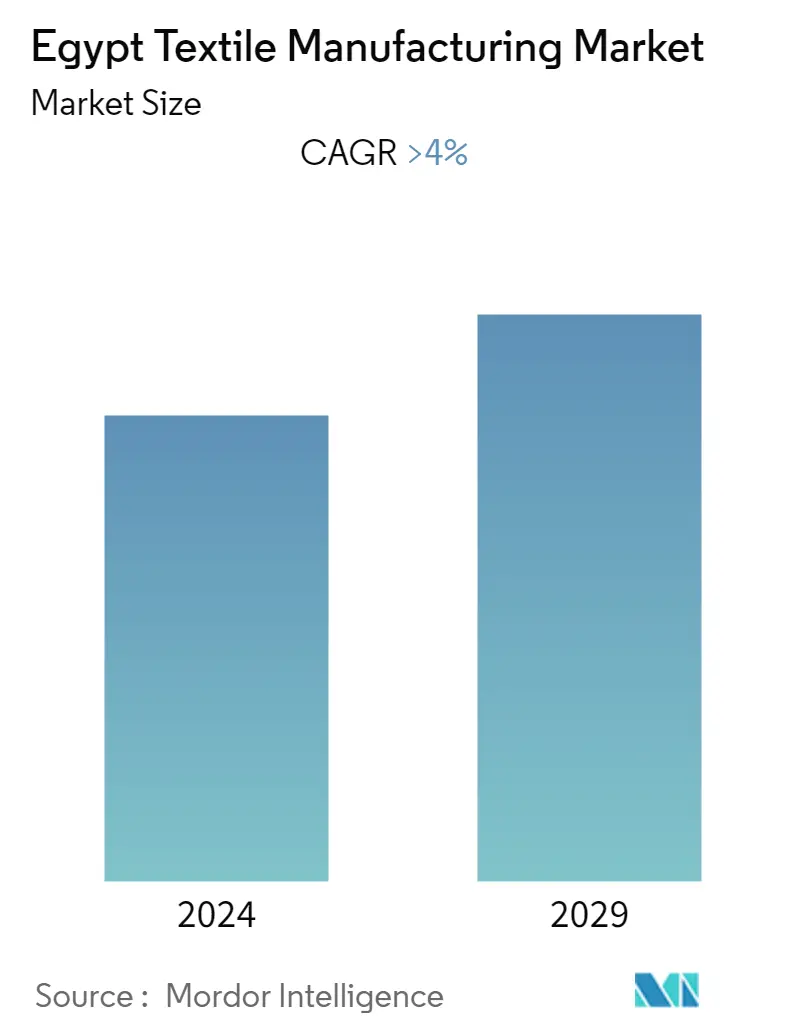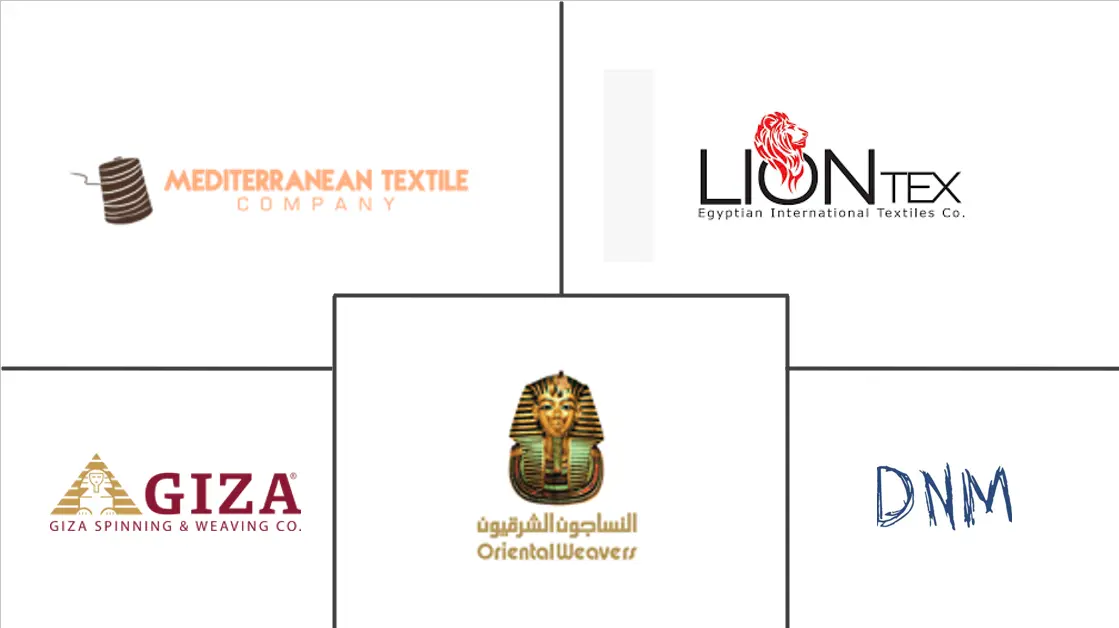Market Size of Egypt Textile Manufacturing Industry

| Study Period | 2019 - 2029 |
| Base Year For Estimation | 2023 |
| Forecast Data Period | 2024 - 2029 |
| Historical Data Period | 2019 - 2022 |
| CAGR | > 4.00 % |
| Market Concentration | Low |
Major Players
*Disclaimer: Major Players sorted in no particular order |
Egypt Textile Manufacturing Market Analysis
The Egyptian textile manufacturing industry is anticipated to register a CAGR of over 4% during the forecast period. The textile manufacturing industry had been hit hardest during the COVID-19 outbreak. According to Egypt's Garment Export Council, exports in the first half of 2020 fell by 29%, while the decline in output reached 40%. Companies also faced serious financial problems as international companies began canceling orders and delaying payments and deliveries. However, exports began to recover from the fourth quarter of 2020, ending 2020 "slightly" with a 14% decline in total export value.
- Egypt's textile manufacturing industry is the second largest industry, with a 25% share in the entire apparel sector, which accounts for 3% of GDP, and it is largely affected by the pandemic. Even with factories remaining open, textiles exports slumped 14% in 2020 to USD 2.81 billion compared to 3.721 billion in 2019. It is recovering due to rising foreign investments of USD 17.5 billion and the government trying to quadruple textile and garment exports by 2025.
- The textile industry is one of the five backbone industries of the Egyptian economy. It is a key supplier of primary textile materials to garment, Home Textile Makers, and other industries. Both domestically and internationally, with having duty-free market access to the United States and European Union countries' textiles markets, it accounts for 50% of its exports to the United States and 30% to European countries.
- In March 2022, Egypt planned to open the world's largest textile factory in the city of El-Mahalla. With approximately 185,000 spinning mills, the mill is planned for a daily production capacity of 30 tons of fine yarn and 25 tons of thick yarn. It announced incentives to grow high-quality cotton that fulfill factory needs, which are expected to create opportunities for the players operating in the market.
Egypt Textile Manufacturing Industry Segmentation
Textile refers to materials that are made from fibers, thin threads, or filaments that are natural, manufactured, or a combination. Textiles are created by interlocking these yarns in specific patterns, resulting in a length of cloth. The textile fibers are spun into yarn and then made into fabric by different methods like weaving, knitting, and felting.
The report aims to provide a detailed analysis of the Egypt textile manufacturing industry. It focuses on market dynamics, technological trends, COVID-19 impact, etc.
The Egyptian textile manufacturing market is segmented by textile type (fiber, yarn, fabric, garment, and other textiles), process type (spinning, weaving, knitting, finishing, and other process types), and machinery type (simple machines, automated machines, and console/assembly line installations). The report offers the market size in value terms in USD for all the abovementioned segments.
| Textile Type | |
| Fiber | |
| Yarn | |
| Fabric | |
| Garment | |
| Other Textiles |
| Process Type | |
| Spinning | |
| Weaving | |
| Knitting | |
| Finishing | |
| Other Process Types |
| Machinery Type | |
| Simple Machines | |
| Automated Machines | |
| Console/Assembly Installations |
Egypt Textile Manufacturing Market Size Summary
The Egyptian textile industry, a crucial component of the nation's economy, is poised for growth despite the challenges posed by the COVID-19 pandemic. As the second largest industry in Egypt, it holds a significant share of the apparel sector and contributes notably to the country's GDP. The industry faced severe setbacks during the pandemic, with substantial declines in exports and production. However, recovery began in late 2020, supported by rising foreign investments and government initiatives aimed at boosting textile and garment exports. The industry benefits from duty-free access to key markets in the United States and Europe, which constitutes a significant portion of its export revenue. The planned establishment of the world's largest textile factory in El-Mahalla is expected to further enhance production capabilities and create new opportunities within the market.
Egypt's textile sector is characterized by its reliance on cotton, both as a raw material and an export commodity. The country has seen an increase in cotton production and exports, driven by rising global demand and higher cotton prices, which have incentivized local farmers to expand their acreage. Despite these positive trends, the industry faces challenges such as higher local raw material costs, increased competition from countries with lower wages and higher productivity, and the need for modernization in equipment and techniques. The market is relatively fragmented, with numerous players contributing to its dynamics. The pandemic has also prompted shifts in consumer preferences, encouraging companies to adopt modern manufacturing methods, which is expected to create further opportunities for growth in the coming years.
Egypt Textile Manufacturing Market Size - Table of Contents
-
1. MARKET DYNAMICS AND INSIGHTS
-
1.1 Market Overview
-
1.2 Market Dynamics
-
1.2.1 Market Drivers
-
1.2.2 Market Restraints
-
1.2.3 Market Opportunities
-
-
1.3 Value Chain/Supply Chain Analysis
-
1.4 Industry Attractiveness- Porter's Five Forces Analysis
-
1.4.1 Threat of New Entrants
-
1.4.2 Bargaining Power of Buyers/Consumers
-
1.4.3 Bargaining Power of Suppliers
-
1.4.4 Threat of Substitute Products
-
1.4.5 Intensity of Competitive Rivalry
-
-
1.5 Technological Innovations in the Market
-
1.6 Government Initiatives and Regulations
-
1.7 Impact of COVID-19 on the Market
-
-
2. MARKET SEGMENTATION
-
2.1 Textile Type
-
2.1.1 Fiber
-
2.1.2 Yarn
-
2.1.3 Fabric
-
2.1.4 Garment
-
2.1.5 Other Textiles
-
-
2.2 Process Type
-
2.2.1 Spinning
-
2.2.2 Weaving
-
2.2.3 Knitting
-
2.2.4 Finishing
-
2.2.5 Other Process Types
-
-
2.3 Machinery Type
-
2.3.1 Simple Machines
-
2.3.2 Automated Machines
-
2.3.3 Console/Assembly Installations
-
-
Egypt Textile Manufacturing Market Size FAQs
What is the current Egypt Textile Manufacturing Market size?
The Egypt Textile Manufacturing Market is projected to register a CAGR of greater than 4% during the forecast period (2024-2029)
Who are the key players in Egypt Textile Manufacturing Market?
Egyptian International Textile Co. - Liontex., Mediterranean-textile company, Giza spinning and weaving S.A.E., DNM textile for spining weaving and dyeing and Oriental weavers are the major companies operating in the Egypt Textile Manufacturing Market.

